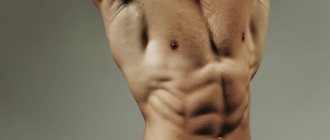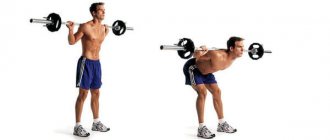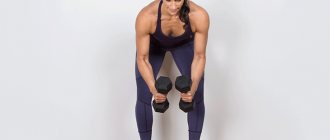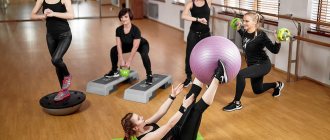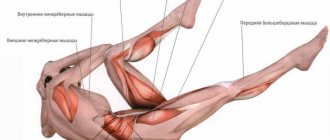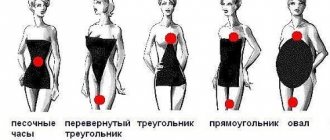Bends with dumbbells to the sides or lateral bends are a very effective and relevant exercise in modern training. It is aimed at increasing strength, endurance, as well as the mass and volume of the oblique abdominal and lumbar muscles. This exercise can be performed using dumbbells, barbells, or a pulley machine. Athletes of various sports use lateral bends in the training process. The oblique abdominal muscles are stabilizing and auxiliary when performing various exercises in the gym. And in many types of martial arts and martial arts, the oblique abdominal muscles protect athletes from enemy blows and allow them to dodge blows.
Benefits and disadvantages of exercise
Benefit:
- An excellent option for developing the oblique abdominal muscles.
- Can be used both at home and in the gym.
- Relevant for any athletes, both in terms of physical fitness, and for athletes of any sports.
- Can be used to develop strength, also in training aimed at weight loss.
- Exercise helps improve posture.
The disadvantage can be considered an increase in waist size due to the development of oblique muscles.
Body tilts with dumbbells
Almost any simple exercise can be improved a little if you start doing it with weights.
How to do side bends with dumbbells? You should start by choosing a weighting agent. For beginner girls, it will be enough to take small dumbbells weighing 0.5-2 kg. Advanced athletes can choose the 2-4 kilogram option. The technique is the same as for regular bends: take a dumbbell in one hand, place the other in a convenient way and begin to tilt the body. During movement, the weighting material should fit snugly to the body. At the lowest point of the inclination, as with a simple exercise, you need to linger for a few seconds, after which you can return to the starting position.
If you work out in a gym, ask your instructor to create an individual program and select the optimal number of repetitions. If you are working out at home, remember that dumbbell curls are a strength exercise and do not require too many repetitions. Follow all the rules of execution and train regularly, and then you will definitely achieve success!
Technique for performing inclines with dumbbells
- To perform the exercise, you need to choose the appropriate weight.
- Stand straight with your feet shoulder-width apart.
- The hand with the dumbbell should be lowered down without bending at the elbow joint.
- The movement is performed strictly in a vertical position. Do not bend or lean backwards or forwards.
- During the downward movement, inhale; while returning the body, exhale.
Body tilts[edit | edit code]
Inventory
: dumbbells.
Core muscles
: oblique muscles and muscles of the lower abdomen.
Additional muscles
: thigh muscles, lumbar.
Level of training
: initial.
Step 1
. Feet shoulder width apart. Hands with dumbbells are bent at the elbows and raised above the head.
Step 2
. Tilt your body to the left. Don't give up. Return to the starting position.
Step 3
. Repeat the bend on the other side.
Do not lean forward or backward while moving, only to the sides. Don't bend your knees.
Options for side bends with dumbbells
There are many different options for performing this exercise.
- These include barbell bends . This is one of the most popular options. Due to a shift in the center of gravity, the load on the stabilizer muscles and the main muscle group increases.
- Bend-overs with a kettlebell are identical in technique to bend-overs with dumbbells.
- There is a tilt option using the lower and upper crossover blocks with a “D”-shaped handle .
Side bends - what muscles work
Side bends are extremely beneficial for human health. During lateral bending, tension is felt not only in the oblique abdominal muscles, but also in the legs. The main rule is to keep your back perfectly straight to avoid injury to the spine and joints.
During the bend, the main muscle groups are involved, namely the obliques, buttocks, legs, back, thighs and buttocks. If you perform a muscle bend using weights, the result will be better than without it.
Technique Recommendations
- Remember that when performing any type of lateral bending, you should keep your body strictly vertical and not lean forward or backward.
- The pelvis should remain motionless during the exercise.
- You can increase efficiency by adding an overhead raise. This will increase the load on the oblique abdominal muscles.
- Women need to be especially careful, because exercise can increase your waist size!
- More weight increases the effectiveness of such exercises, however, too much weight can cause spinal injuries.
Exercise technique
Side bends with weights are a simple exercise. It is easy even for beginners.
The technique for performing the exercise is as follows:
- Feet should be placed shoulder width apart. Take a dumbbell in one hand, place the other on your belt or put it behind your head.
- The abdominal muscles must be tense, the shoulders should be straightened, the hips should be fixed (they should not move left or right), and the tailbone should be twisted forward. There is no deflection in the lower back.
- Bends should be done in a strictly vertical plane to a comfortable position. First, we bend to the side from the dumbbells (the opposite side of the body is stretched at this moment), then we gently move to a tilt to the side from the dumbbell (at this moment the oblique muscles work). During movement, the abs are tense, they do not relax for a second. The dumbbell moves strictly along the leg.
- If it is difficult to perform a lateral bend on straight legs, you can bend your knees slightly.
Incorrect bending can lead to a number of problems:
- When bending over with a relaxed stomach and arching in the lower back, the load falls not on the oblique muscles, but on the lumbar spine. This is fraught with compression injuries, up to the appearance of hernias. Of course, in this case there can be no talk of any process of losing weight.
- Turning the body during the exercise can lead to abrasion of the intervertebral discs and pinched nerve endings.
- Training with heavy and medium weights will help increase the volume of the oblique muscles. And this will only increase the width of the waist.
Implementation recommendations
- The exercise can be performed to gain weight . In this case, the classic training scheme is suitable - with a number of repetitions from eight to twelve and four approaches.
- Bends are also performed in workouts aimed at weight loss . They can be used in both drop sets and supersets. The actual number of repetitions will be in the range from fifteen to twenty, 3-4 sets.
- This exercise should be included in a set of exercises aimed at training the abs. It can be perfectly alternated with crunches and leg raises, and you can also perform all three exercises in turn (twisting, leg lifts and side bends).
Rules and technique of execution
The most important condition for performing this exercise correctly is keeping your torso straight. Before you start bending over, you should straighten your back, tighten your buttocks and abs. When bending, make sure that the movement is made only to the side, but deviating from a straight line forward or backward is not only impossible, but very dangerous. Such mistakes in training an adult can seriously damage the spine. The movement itself – tilting – should be accomplished by tensing the abdominal muscles. The exercise should not be performed too often; if you train seriously, it will be enough to include it in your exercises 1-2 times a week. For home training, inclines are suitable for repetition every other day, but on condition that they are performed in the amount of 6-15 repetitions.
Alternative to side bends
This exercise does not work the obliques in the same way that lateral bends do, and therefore, unlike lateral bends, this exercise will not help you improve stability in the transverse plane. However, this exercise works well on other muscle structures of the abdominal area.
An alternative exercise to lateral bending.
Lie on the floor so that your hips and lower back are on a towel folded several times. Your hands should be on the floor and perpendicular to your torso. Raise your legs so that they are straight and vertical. Keeping them together and straight, lower them to your left side so that your feet touch the floor. Then return them to a vertical position and slowly lower them to the right side. Then again to the left and so on. Do the required number of repetitions, the same for both sides. As you lower your legs, keep them in the same plane they were in when you started upright—do not move them forward or backward. When you can do 20 technical reps on each side, attach additional weights to your legs or ankles. Then reduce the number of reps per set. Take increasing the weight on this exercise very seriously. As a (at least short-term) alternative to using additional weights, you can do this exercise immediately after an intense set of abdominal crunches. Work your way up to at least 20 repetitions before using additional weights.
Description of the exercise
This exercise is very good at strengthening your oblique muscles. But I don’t recommend doing it with heavy weights and too often. Especially girls. Since it can lead to an increase in your oblique muscles in volume, and therefore to a thickening of your waist.
Main features
1. Place your feet wider than your shoulders. This way you can bend lower without moving your pelvis. And this is quite important. The pelvis must be locked in place.
2. Lean straight to the side. Many, in pursuit of a deeper tilt, move their body forward in order to bend a little lower. There is no need to do this.
3. Don't hold dumbbells in each hand. Otherwise, the dumbbells will create a counterweight for each other. Thereby nullifying all your efforts. Train one side first and then the other.
4. Alternatively, you can perform bends with your arms straight above your head. With this option, your oblique muscles will work even without a dumbbell. And if you take a 3-5 kg dumbbell with both hands, you won’t find it too small.
5. When rising, you need to deviate slightly towards the working muscle, as if contracting it more strongly. This will increase the amplitude and efficiency of the exercise.
6. The weight should be such that you can do at least 15 repetitions. The lighter the weight and the more repetitions, the less likely it is to build up your oblique muscles and increase your waist.
Variations of lateral tilts
Side bends with a barbell are performed to strengthen the oblique abdominal muscles. In this case, the back muscles are additionally involved. The exercise consists of the athlete holding a barbell on his shoulders, bending to the sides, and then returning to the starting position.
Lateral bends in a vertical block require the presence of a block simulator, holding the rope of which the athlete bends to the sides. This exercise, in addition to directly training the oblique abdominal muscles, additionally loads the biceps.
Bending the body with dumbbells, in addition to the oblique abdominal muscles, involves the muscles of the hips and lower back, and also involves the shoulder joints and abdominal muscle group. The starting position for this exercise is for the athlete to hold dumbbells in bent arms above his head. Then he begins to bend to the sides without bending his knees. There are other variations of dumbbell side bends, depending on the position of the dumbbells. Thus, a well-known exercise is when an athlete performs lateral bends with dumbbells, lowering his hand from the dumbbells to his leg.
